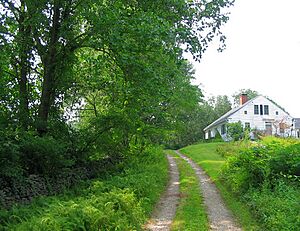Edwin Way Teale facts for kids
Quick facts for kids
Edwin Way Teale
|
|
|---|---|

Teale in 1976
|
|
| Born | June 2, 1899 Joliet, Illinois, United States |
| Died | October 18, 1980 (aged 81) |
| Occupation | Naturalist, author, photographer |
| Period | 1930–1980 |
| Genre | Natural history |
| Subject | Nature |
| Spouse |
Nellie Donovan
(m. 1923; died 1993) |
| Children | 1 |
Edwin Way Teale (born June 2, 1899 – died October 18, 1980) was an American naturalist, a person who studies nature, and a talented photographer and writer. His books and photos show us what the environment was like across North America from the 1930s to the 1980s. He is most famous for his book series called The American Seasons. These four books describe his amazing journey of over 75,000 miles (about 120,700 km) across North America, following the changing seasons.
Contents
Growing Up and Learning
Edwin Alfred Teale was born in Joliet, Illinois. He loved nature from a young age, especially during his summer visits to his grandparents' farm in Indiana. He wrote about these special times in his book Dune Boy (1943).
When he was nine, Edwin decided he wanted to be a naturalist. At age 12, he even changed his name to Edwin Way Teale.
He went to Earlham College and earned a degree in English literature in 1922. After college, he taught at Friends University in Wichita, Kansas, from 1922 to 1924. He also coached debate and advised the yearbook. In 1923, he married Nellie Imogene Donovan, whom he had met at Earlham College.
In 1924, Edwin and Nellie moved to New York City. Edwin wanted to continue his studies at Columbia University. He chose Columbia partly because it was in New York, which made it easier to send his writings to magazines. He earned his Master of Arts degree from Columbia University in 1926.
Edwin Teale's Career
Edwin Teale worked for 13 years as a writer for Popular Science magazine in New York. He wrote about many different topics there.
In 1937, his first book about nature photography was published. It was called Grassroots Jungle. This book featured 200 of his insect photographs. Many of these pictures were taken on a small plot of land near his home in Long Island. Later, in 1941, he published The Golden Throng, a book about bees with both text and photos.
When he was 42, Teale decided to leave Popular Science. He became a full-time freelance photographer and nature writer.
In 1942, he wrote Byways to Adventure: A Guide to Nature Hobbies. He also wrote Near Horizons, which won the John Burroughs Medal in 1943 for excellent nature writing.
The American Seasons Series
In March 1945, Edwin and Nellie's son, David, was sadly killed in Germany during the war. To help cope with their grief, the Teales started taking trips across the country.
On February 14, 1947, they began a huge 17,000-mile (about 27,350 km) road trip in their black Buick car. They first went to the Florida Everglades. Then, they traveled northward, following the arrival of spring. Teale wrote about this amazing adventure in his book North with the Spring.
This book was the first of his famous American Seasons series. The other three books were:
- Journey Into Summer
- Autumn Across America
- Wandering Through Winter
Wandering Through Winter won the prestigious Pulitzer Prize for General Non-Fiction in 1966.
Later Life and Work
Teale was also involved in many scientific groups. He was president of the New York Entomological Society from 1944 to 1949. He also led the Brooklyn Entomological Society from 1949 to 1953.
In 1958, Teale became president of the Thoreau Society, which studies the works of writer Henry David Thoreau. That same year, his book Autumn Across America was added to the White House Library. He received several awards and honorary degrees for his contributions to literature and nature.
In 1959, the Teales moved from their home on Long Island to a 130-acre (about 53 ha) farm in Hampton, Connecticut. They named their new home "Trail Wood." Teale wrote about this farm in his book A Naturalist Buys an Old Farm (1974). He described the property further in A Walk through the Year (1978). Today, Trail Wood is a nature preserve managed by the Connecticut Audubon Society.
In 1975, Teale received the Ecology Award and the Conservation Medal for his work in protecting nature. He was also a respected member of important scientific groups like the American Association for the Advancement of Science.
His Final Years
Edwin Way Teale passed away in 1980 while working on a book called A Conscious Stillness: Two Naturalists on Thoreau's Rivers with author Ann Zwinger. He had almost finished his part of the book, so he was still listed as a co-author when it was published in 1982.
Nellie Teale, his wife, died in July 1993 at the age of 92.
How He Is Remembered
In 2009, the Indiana Historical Bureau placed a special historic marker near Teale's grandparents' farm in Porter County, Indiana. This marker honors Teale and recognizes that his time at the farm inspired his love for nature.
His Writings and Collections
The University of Connecticut has a large collection of Edwin Way Teale's papers. This collection includes:
- His notes and drafts for his books
- His early childhood writings
- Articles he wrote for magazines and newspapers
- His personal and professional letters
- Family documents and scrapbooks
- His photographs (prints, negatives, and slides)
- His personal library
There is also a box of original materials from John Burroughs, another famous naturalist, that Teale collected.
Teale also left his collection of books, letters, and other items related to Henry David Thoreau and Ralph Waldo Emerson to The Concord Free Public Library in Concord, Massachusetts.



